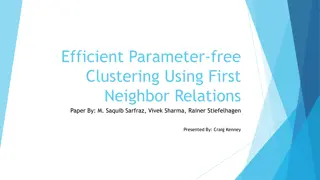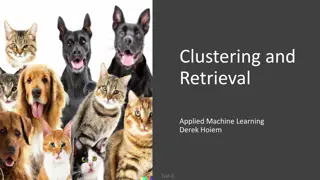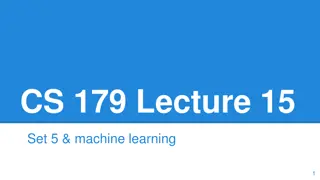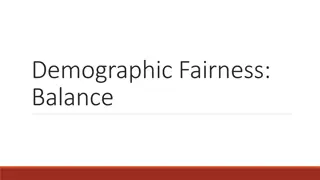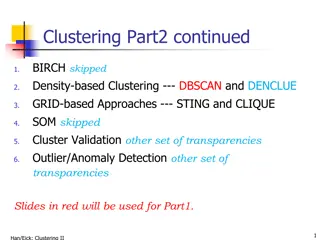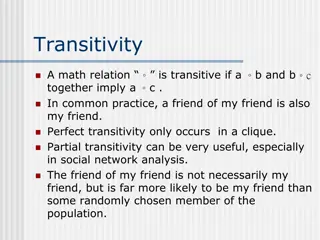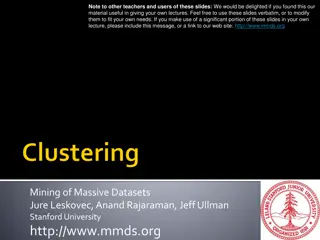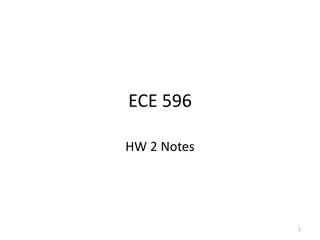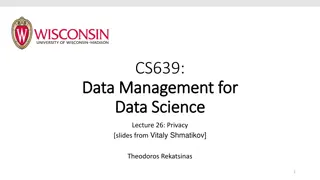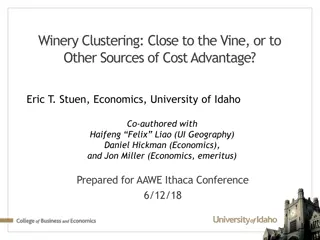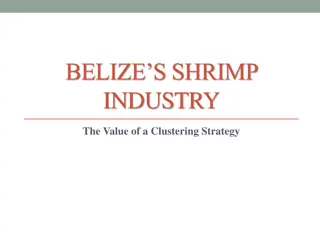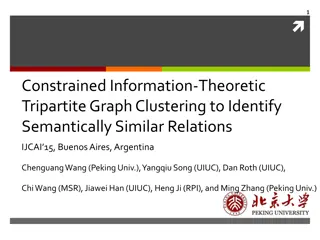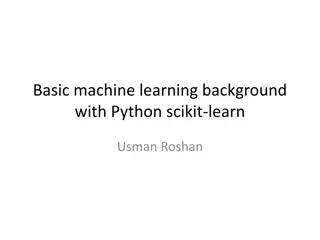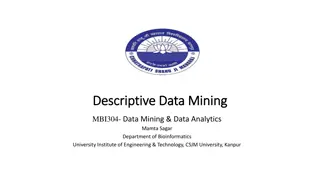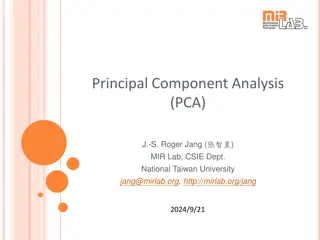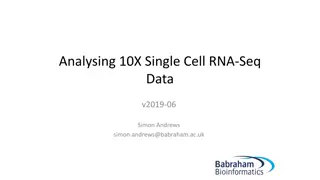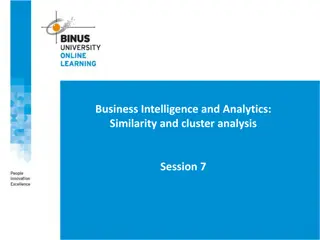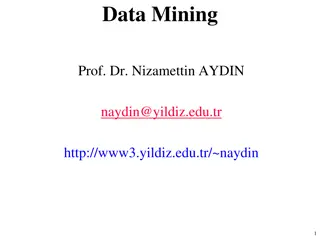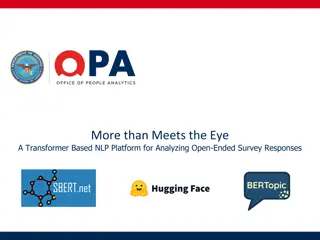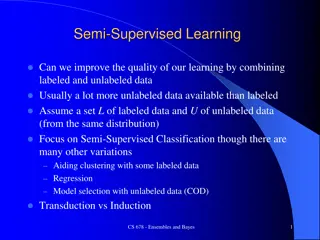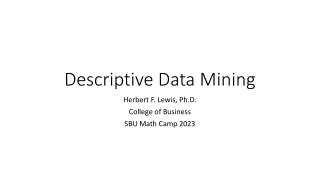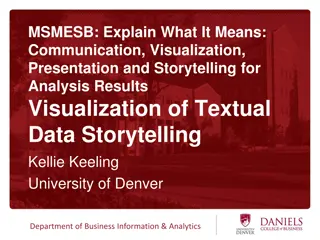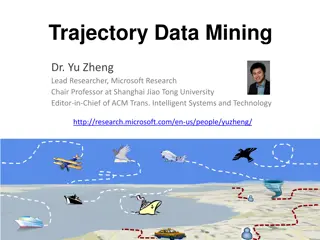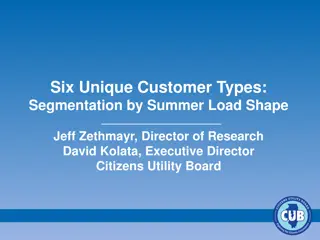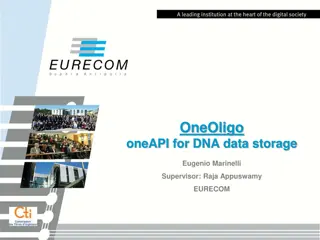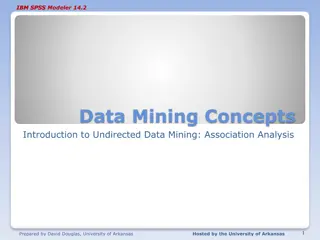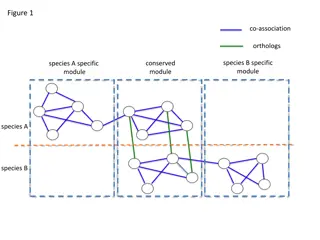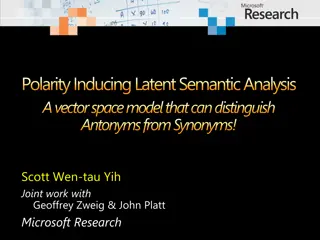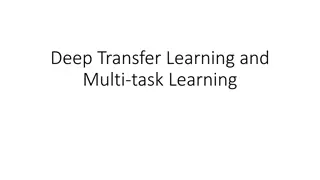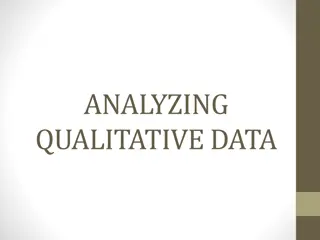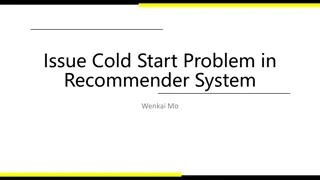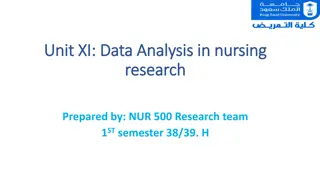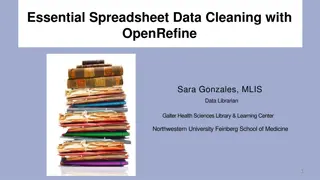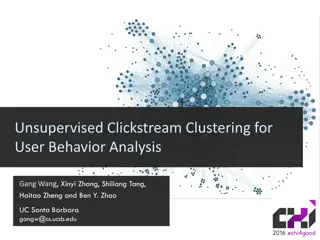Understanding Clustering Methods for Data Analysis
Clustering methods play a crucial role in data analysis by grouping data points based on similarities. The quality of clustering results depends on similarity measures, implementation, and the method's ability to uncover patterns. Distance functions, cluster quality evaluation, and different approaches like partitioning, hierarchical, density-based, and grid-based are discussed. Various clustering methods such as k-means, DBSCAN, EM, and more are explored, highlighting the importance of user-guided and model-based clustering.
Download Presentation

Please find below an Image/Link to download the presentation.
The content on the website is provided AS IS for your information and personal use only. It may not be sold, licensed, or shared on other websites without obtaining consent from the author. Download presentation by click this link. If you encounter any issues during the download, it is possible that the publisher has removed the file from their server.
E N D
Presentation Transcript
DWM By Kadiyala Vijaya Kumar Ravindra College of Engineering for Women Kurnool 518452, Andhra Pradesh, India Asst. Professor Dept. of CSE RCEW, RCEW, Pasupula Pasupula (V), Near Near Venkayapalli (V), Nandikotkur Nandikotkur Road, Venkayapalli, , KURNOOL KURNOOL Road,
A good clustering method will produce high quality clusters with high intra-class similarity low inter-class similarity The quality of a clustering result depends on both the similarity measure used by the method and its implementation The quality of a clustering method is also measured by its ability to discover some or all of the hidden patterns RCEW, RCEW, Pasupula Pasupula (V), Near Near Venkayapalli (V), Nandikotkur Nandikotkur Road, Venkayapalli, , KURNOOL KURNOOL Road,
Dissimilarity/Similarity metric: Similarity is expressed in terms of a distance function, typically metric: d(i, j) There is a separate quality function that measures the goodness of a cluster. The definitions of distance functions are usually very different for interval-scaled, boolean, categorical, ordinal ratio, and vector variables. Weights should be associated with different variables based on applications and data semantics. It is hard to define similar enough or good enough the answer is typically highly subjective. RCEW, RCEW, Pasupula Pasupula (V), Near Near Venkayapalli (V), Nandikotkur Nandikotkur Road, Venkayapalli, , KURNOOL KURNOOL Road,
Partitioning approach: Construct various partitions and then evaluate them by some criterion, e.g., minimizing the sum of square errors Typical methods: k-means, k-medoids, CLARANS Hierarchical approach: Create a hierarchical decomposition of the set of data (or objects) using some criterion Typical methods: Diana, Agnes, BIRCH, ROCK, CAMELEON Density-based approach: Based on connectivity and density functions Typical methods: DBSACN, OPTICS, DenClue RCEW, RCEW, Pasupula Pasupula (V), Near Near Venkayapalli (V), Nandikotkur Nandikotkur Road, Venkayapalli, , KURNOOL KURNOOL Road,
Grid-based approach: based on a multiple-level granularity structure Typical methods: STING, WaveCluster, CLIQUE Model-based: A model is hypothesized for each of the clusters and tries to find the best fit of that model to each other Typical methods:EM, SOM, COBWEB Frequent pattern-based: Based on the analysis of frequent patterns Typical methods: pCluster User-guided or constraint-based: Clustering by considering user-specified or application-specific constraints Typical methods: COD (obstacles), constrained clustering RCEW, RCEW, Pasupula Pasupula (V), Near Near Venkayapalli (V), Nandikotkur Nandikotkur Road, Venkayapalli, , KURNOOL KURNOOL Road,
Relies on a density-based notion of cluster: A cluster is defined as a maximal set of density-connected points Discovers clusters of arbitrary shape in spatial databases with noise RCEW, RCEW, Pasupula Pasupula (V), Near Near Venkayapalli (V), Nandikotkur Nandikotkur Road, Venkayapalli, , KURNOOL KURNOOL Road,
Arbitrary select a point p Retrieve all points density-reachable from p w.r.t. Eps and MinPts. If p is a core point, a cluster is formed. If p is a border point, no points are density-reachable from p and DBSCAN visits the next point of the database. Continue the process until all of the points have been processed. RCEW, RCEW, Pasupula Pasupula (V), Near Near Venkayapalli (V), Nandikotkur Nandikotkur Road, Venkayapalli, , KURNOOL KURNOOL Road,
RCEW, RCEW, Pasupula Pasupula (V), Near Near Venkayapalli (V), Nandikotkur Nandikotkur Road, Venkayapalli, , KURNOOL KURNOOL Road,


